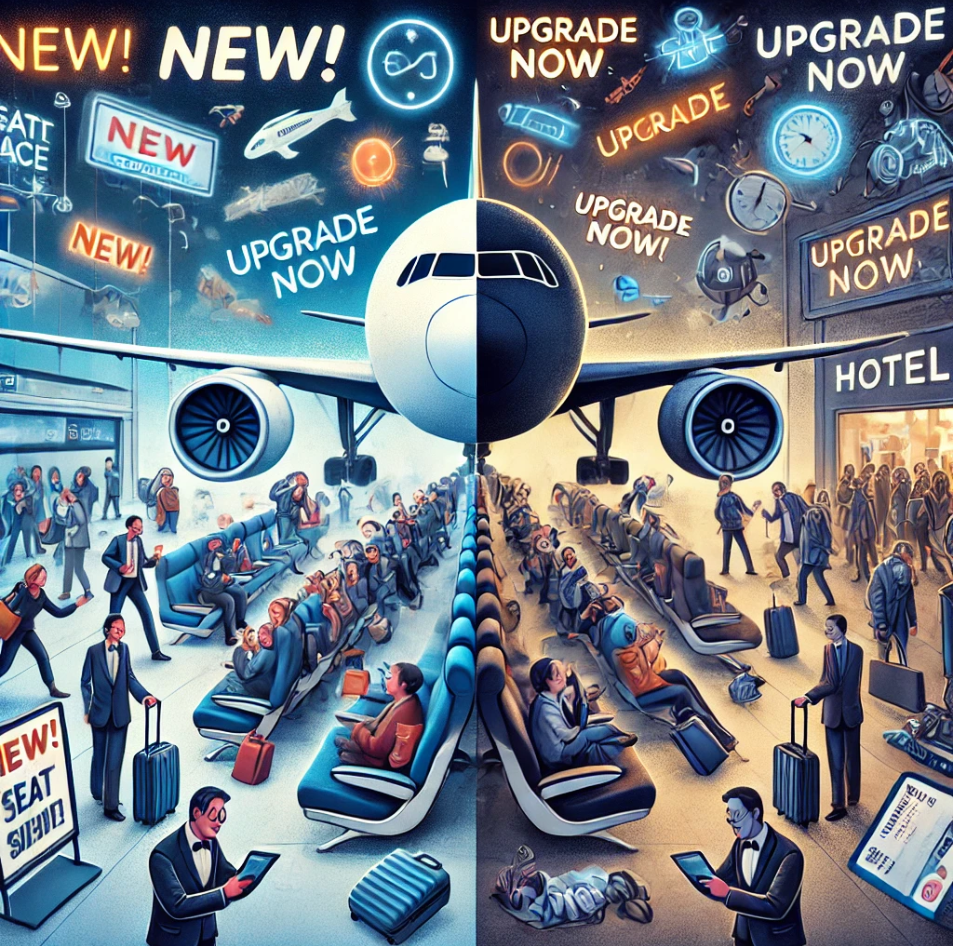By Summit Management | April 30, 2025
Planned obsolescence—a cunning business tactic where products and services are intentionally designed to have a limited lifespan—ensures consumers keep coming back for more. In the travel industry, airlines and hotels masterfully deploy this strategy to boost profits while keeping travelers hooked. Buckle up as we unpack how these sectors manipulate demand, drive spending, and balance innovation with exploitation, with fresh insights into their tactics and their impact on you.
Airlines: Flying High on Forced Upgrades
Airlines don’t just transport you—they engineer reasons to make you spend more, often under the guise of “progress.” Here’s how they pull it off:
Relentless Fleet Upgrades
Tactic: Airlines phase out older planes for newer models boasting cutting-edge tech, better fuel efficiency, and plush interiors. For example, Boeing’s 787 Dreamliner or Airbus A350s promise quieter rides and mood lighting, while older 737s or A320s feel dated by comparison.
Impact: Travelers gravitate toward airlines with shiny new fleets, sidelining carriers with “outdated” planes. This creates a race to refresh fleets every 5-10 years, even when older models are perfectly safe. In 2024, Delta invested $14 billion in new aircraft, signaling a clear push to make their old planes obsolete.
Why It Hurts: You’re subtly coerced into choosing pricier tickets on newer planes, as older fleets are relegated to budget routes or retired entirely.
Cabin Refits and Amenity Overhauls
Tactic: Airlines frequently revamp cabin layouts—think lie-flat beds in business class, Wi-Fi 2.0, or 4K in-flight entertainment screens. United’s Polaris business class, rolled out in 2023, set a new standard, making older cabins feel prehistoric.
Impact: These upgrades fuel a cycle of upselling. Passengers pay premiums for “new” experiences, while standard economy seats shrink to push upgrades. In 2024, global airlines spent $25 billion on cabin retrofits, per IATA, to keep the allure of “new” alive.
Why It Hurts: You’re nudged into splurging on premium seats or new services, as basic offerings are deliberately left underwhelming.
Frequent Flyer Traps:
Tactic: Mileage programs like American’s AAdvantage or Emirates Skywards promise rewards but devalue miles through inflation or rule changes. For instance, Delta’s 2024 SkyMiles overhaul increased redemption thresholds by up to 20% for some awards.
Impact: Travelers rush to burn miles before they lose value, booking trips they might not need. This manufactured urgency drove a 15% spike in award travel redemptions in 2024, per Airlines for America.
Why It Hurts: You’re pressured to travel more often, often on the airline’s terms, to avoid losing your hard-earned rewards.
Hotels: Checking You In for More Spending
Hotels play the obsolescence game just as fiercely, using renovations and loyalty schemes to keep guests booking—and spending.
Perpetual Renovations
Tactic: Hotels overhaul rooms, lobbies, and amenities every 5-7 years to stay “fresh.” Marriott’s 2024 redesign of 200 properties introduced smart thermostats and minimalist aesthetics, rendering older properties passé.
Impact: Guests flock to newly renovated hotels, shunning those with dated decor. In 2023, 60% of travelers surveyed by STR preferred hotels renovated within the last three years. This cycle ensures a constant stream of bookings at premium rates.
Why It Hurts: You pay higher rates for “new” rooms, while perfectly functional older properties are sidelined or forced to discount heavily.
Loyalty Program Manipulation
Tactic: Hotel chains like Hilton Honors and IHG Rewards impose point expiration dates or adjust redemption rates. In 2024, Hyatt raised award night costs by 15% for peak seasons, forcing guests to act fast.
Impact: Guests book more stays to use points before they expire or become less valuable. This drove a 10% increase in loyalty-driven bookings in 2024, per Hotel News Now.
Why It Hurts: You’re pushed to plan trips around point deadlines, not your actual needs, locking you into the hotel’s ecosystem.
The Consumer Conundrum:
Planned obsolescence in travel is a double-edged sword. On one hand, it fuels innovation—newer planes are 20% more fuel-efficient, per ICAO, and modern hotels offer seamless tech like mobile check-in. These upgrades enhance comfort and sustainability. But the dark side is clear: travelers are manipulated into spending more, faster. The constant churn of “new” breeds frustration, with 68% of travelers in a 2024 Skift survey feeling airlines and hotels prioritize profits over customer value. This perception erodes trust, leaving consumers feeling like pawns in a revenue-driven game.
The Bigger Picture:
The travel industry’s reliance on planned obsolescence isn’t just about shiny new toys—it’s a structural necessity. Airlines face $600 billion in debt from the pandemic era, per IATA, and hotels grapple with rising operational costs. Obsolescence ensures cash flow but risks alienating customers. Some brands are pushing back: Southwest’s “no-frills” model resists flashy upgrades, and budget hotel chains like Motel 6 prioritize affordability over constant renovations. Yet, the industry’s heavyweights—think Delta, Marriott—double down on this strategy, betting on consumer FOMO.
Conclusion: Travel Smarter, Not Harder:
Planned obsolescence in travel is a calculated move to keep you spending. Airlines and hotels dangle the carrot of “new and improved” while quietly devaluing what you already have. As a traveler, you can fight back: compare fleet ages on sites like Planespotters.net, book award travel early to beat devaluations, and prioritize value over novelty. The industry may play its game, but with savvy choices, you can stay one step ahead.
#JoeKnows #travel# #IncentiveTravel # #AskMrLipman #AskClaudette #NexttNormalMeetings

